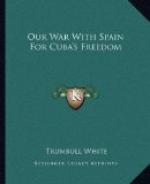Hobson Wins fame.
On Thursday, June 2, Admiral Sampson decided to send the collier Merrimac into the bay of Santiago and sink it in the channel’s narrowest part, for the purpose of holding Cervera and his fleet in the harbor, until the time when their capture or destruction seemed advisable. He called for volunteers, explaining that it was a desperate mission, death being almost certain for all those who ventured in.
Then the navy showed the stuff of which it is made. Admiral Sampson wanted eight men. He could have had every officer and man in the fleet, for all were more than ready. Lieutenant Eichmond P. Hobson was selected to command the expedition, and Daniel Montague, George Charette, J. C. Murphy, Osborn Deignan, George F. Phillips, Francis Kelly and B. Clausen were detailed to accompany him.
Just before 3 o’clock on the morning of the 3d the collier, deeply laden with, ballast material and some coal, was headed without preliminary maneuver straight for the entrance, over which the remaining batteries from Morro frowned from one side, and those from Socapa from the other. In the darkness of the early morning the Merrimac, without a light showing anywhere, dashed within the line of the forts before it was discovered, Sampson’s ships thundering at the enemy’s batteries to divert their attention from the collier. The Spaniards soon detected it, however, and brought every possible gun to bear. In the face of a terrific fire of shot and shell from Spanish guns the Merrimac ran into the narrow channel, where it was swung across and anchored. Then Lieutenant Hobson blew a hole in the ship’s bottom and with his seven men took to a boat. They first made an effort to row out of the harbor and regain the American fleet, but soon realizing that, to attempt to pass the aroused batteries would mean certain death to all, they turned and rowed straight towards the Spanish squadron, and surrendered to Admiral Cervera, who held them as prisoners of war.




